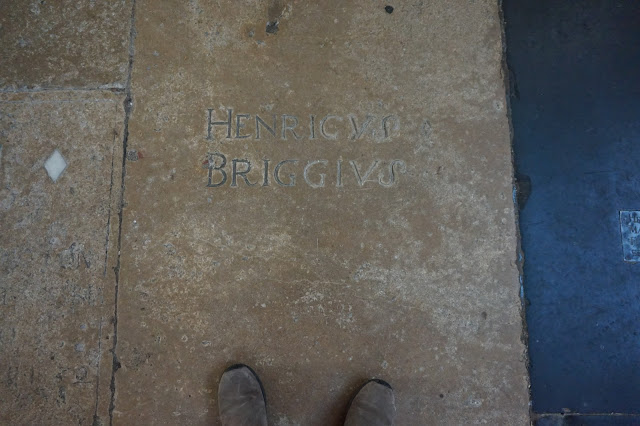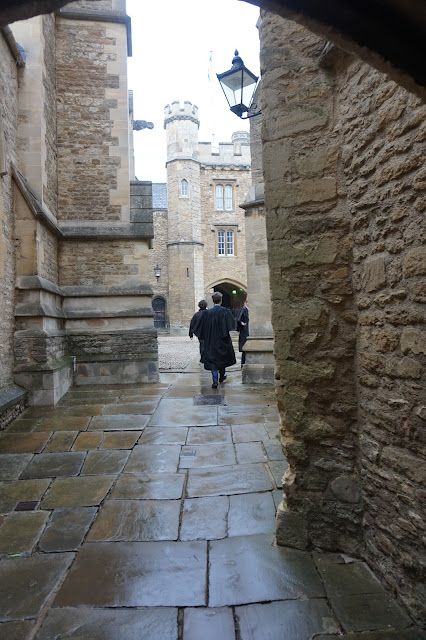
It was an interesting first few days in Oxford with graduations happening. One way in which that impacted me - other than getting to see all the cool regalia - is that I had an unusual experience touring the Bodleian Library. Normally a tour consists of the Humphrey Library and the Divinity School, but the Divinity School was being used for students to don their robes for graduation, so only the Humphrey Library was open, but there were no students in it - again, due to graduations. At first I was bummed that I was going to miss out on part of what I would normally see, but I was told that I could come back the next day with my ticket and say I was back to see the Divinity School which I had missed due to graduation. This was the best of both worlds, as I ended up with more time in each place and also got to be in the Humphrey Library without our tour group having to work around students. Both of these places were built in the mid-1400s, and both are directly behind the outer wall you see in the picture above. The Divinity School, was built first, and when Humphrey of Lancaster, 1st Duke of Gloucester donated his books to the university after his death in 1447, a second floor, the Humphrey Library, was built on top of the Divinity School. He donated 281 books, which was unbelievably generous given the value of books then. Prior to this donation, the University of Oxford owned only 20 books. Pictures were not allowed in the Humphrey Library, which is why I didn't upload any to my previous post, which covers the day I toured it. But pictures are allowed in the Divinity School, so I took a ton of pictures. See below!

Beyond the main door in the picture at the top of this post is another door. I'm pretty sure the door pictured here, which opens into the Divinity School, is original to the mid-1400s. Open the door, and enter into a feast for the eyes!
I find the ceiling spectacular, so I couldn't stop taking pictures of it! (Me and the other 30 people who were in here.) If you've seen the Harry Potter films, you may recognize this as the location where the hospital scenes were filmed. I believe it was also used for a scene in the biopic of C. S. Lewis, Shadowlands.

The door that you can see to the right of the photo above opens out to the Sheldonian Theatre (built by Christopher Wren) where Oxford graduations take place. The door was put in so students could put on their gowns in here and then process over to the theatre.
I posted a picture last time of graduates leaving the Sheldonian after graduation. Here are some shots of the exterior of the Divinity School on the side between this and the Sheldonian.


This was on Sunday, May 15. I had started the day by attending eucharist at Magdalen College Chapel, but I've already put up pictures of that chapel in my previous post, having gone to evensong there the night before. After the morning service at Magdalen, all were invited to eat in hall, and I took them up on that offer. It was special to me to get to eat where C. S. Lewis ate on a pretty much daily basis. I also had a wonderful conversation with a student there. He was an Oxford student but from a college other than Magdalen. He's in his third year, a student of economics, and he has made Magdalen his Sunday worship routine. He shared with me that, early on, he and some of his friends had done an "evensong crawl" to check them all out, and they found Magdalen to have the best choir. I felt pretty good at having ended up at the best on my first try, given that Oxford University consists of more than 30 colleges. I believe he said New College was second on his list and that Merton was a "strong third." Merton is where I was going for evensong Sunday night, so that was good to hear!

Merton College Chapel as seen from the street.
Entering Merton College

Past the porter's lodge, and into Merton College, which was a bit more labyrinthine than Magdalen - or others I'd been in previously, such as Queens or Christ Church. I was glad for the sign out front!
Still making my way through passages and onward to the chapel - lots of hallways and alcoves to wander through before arrival.
I think I found the chapel . . . and what a magnificent instrument is contained therein!!

I like to take pictures of all the details so that I can really remember with fulness. Work on this church began in the 1280s, but there have been renovation and alterations over the centuries, of course, yet this has been a place of worship for over 700 years. The angel ceiling was unique among chapel ceilings I had seen (though somewhat reminiscent of the small Guardian Angel side chapel in Winchester Cathedral).


The high altar and east window
The vestments worn here were particularly magnificent, and if you've been reading my blog, you know how excited I get about vestments and regalia, but I didn't want to chase him down to get a closer picture! I thought that would have been pushing it just a bit.
After worship Sunday evening there was fellowship time over refreshments. At my church I'm used to coffee, cookies, and punch being served. Here they serve a selection of two white wines. Orange juice is also available. I did indulge in a lovely Chardonnay, while taking in the organ a bit more closely. I took the picture below with people in it in order to give an idea of scale.

I really was here for worship, but I did have ulterior motives as well. I was looking for the grave of mathematician Henry Briggs whom I know to be buried in this chapel. I also knew that though he was the first Savillian Professor of Geometry and really quite an important figure, that he was also a very humble man and that his stone is very simple, containing only the Latinized version of his name - no dates, no eulogy, nothing but his name. I was having a very hard time finding it, so when the minister approached me, I asked him about it, and he was very gracious - telling me he remembered having seen it and beginning to look along with me. When we couldn't find it after a few minutes, he said, "Let me get Stephen. He'll know where it is." So he asked, and though Stephen too had to take a few moments, he did know the general area in which to look. As it turns out, Stephen is a professor of Early Modern History - so that makes sense.

Briggs was an influential professor, but he was a dedicated Puritan who was not interested in riches or fame. He lived a quiet, studious life.
Here is his simple stone with the Latinized version of his name: Henricus Briggius.
I spent a bit more time exploring the chapel.
The bell ropes in the picture below caught my attention, as I have never seen such outside of the bell ringing chamber up in the tower, but then I remembered that during the service, when the body of Christ was lifted up, the bell was rung once, and when the blood of Christ was lifted up, a bell was rung once. I had wondered how ringers in the bell tower could have known how to time is to perfectly. After seeing this, I am assuming that these two bell ropes are here in the narthex for that purpose.
This was the one service for which I felt distinctly under-dressed - lots of black tie going on here!
I followed a group of students back out the labyrinthine paths. Partly I felt like I was in a Harry Potter film! But I also thought that, aside from the backpack above, I could have been experiencing travel back 500 years in time.
I don't know if this post will capture anyone's attention or stand out in any way, especially since it is just detailed pictures of only two places, but for me this was an amazing day. Worship both at Magdalen and at Merton was profoundly meaningful, and I enjoyed both very much. Having found the grave of Briggs was a big deal for me - like finding the treasure at the end of a treasure hunt (he had worked closely with John Napier, and there are interesting stories related to their meeting and work). And getting the Bodleian tour that I did in the way in which I did was pretty special, and I found the Divinity School to be absolutely gorgeous! I don't know if this post conveys even a token of all that, but I hope it does give at least some small idea.































No comments:
Post a Comment